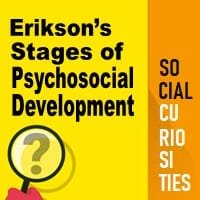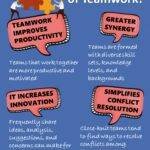
Erikson’s Stages of Psychosocial Development
Erikson’s Stages of Psychosocial Development is a theory introduced in the 1950s by the psychologist and psychoanalyst Erik Erikson. It built upon Freud’s theory of psychosexual development by drawing parallels in childhood stages while expanding it to include the influence of social dynamics as well as the extension of psychosocial development into adulthood.
It posits eight sequential stages of individual human development influenced by biological, psychological, and social factors throughout the lifespan. This bio-psychosocial approach has influenced several fields of study, including gerontology, personality development, identity formation, life cycle development, and more.
Erikson’s Stages
Erikson’s stages of psychosocial development is a comprehensive psychoanalytic theory that identifies a series of eight stages that a healthy developing individual should pass through from infancy to late adulthood.
- Trust versus mistrust: The first stage, which occurs in infancy, is about whether the world is reliable
- Autonomy versus shame and doubt: The second stage, which occurs in toddlerhood, is about developing a sense of autonomy and avoiding shame
- Initiative versus guilt: The third stage, which occurs in early childhood, is about learning to take initiative and develop judgment
- Industry versus inferiority: The fourth stage, which occurs in the early school years, is about developing a sense of pride in accomplishments and abilities
- Identity versus confusion: The fifth stage, which occurs in adolescence, is about developing a sense of self and personal identity
- Intimacy versus isolation: The sixth stage, which occurs in young adulthood, is about forming intimate relationships
- Generativity versus stagnation: The seventh stage, which occurs in middle adulthood, is about developing a desire to leave a legacy and impact younger people
- Integrity versus despair: The final stage, which occurs in late adulthood, is about reflecting on one’s life and whether they feel it was well lived
“The human being, at all times, from the first kick in utero to the last breath is organized into groupings of geographic and historical coherence: family, class, community, nation.”
Erik Erikson
1. Trust vs. Mistrust
From birth to 12 months of age, infants must learn that adults can be trusted. This occurs when adults meet a child’s basic needs for survival. Infants are dependent upon their caregivers, so caregivers who are responsive and sensitive to their infant’s needs help their baby to develop a sense of trust; their baby will see the world as a safe, predictable place.
Unresponsive caregivers who do not meet their baby’s needs can engender feelings of anxiety, fear, and mistrust; their baby may see the world as unpredictable.
If infants are treated cruelly or their needs are not met appropriately, they will likely grow up with a sense of mistrust for people in the world.
2. Autonomy vs. Shame and Doubt
As toddlers (ages 1–3 years) begin to explore their world, they learn that they can control their actions and act on their environment to get results. They begin to show clear preferences for certain elements of the environment, such as food, toys, and clothing. A toddler’s main task is to resolve the issue of autonomy vs. shame and doubt by working to establish independence.
This is the ―me do it‖ stage. For example, we might observe a budding sense of autonomy in a 2-year old child who wants to choose her clothes and dress herself. Although her outfits might not be appropriate for the situation, her input in such basic decisions has an effect on her sense of independence.
If denied the opportunity to act on her environment, she may begin to doubt her abilities, which could lead to low self-esteem and feelings of shame.
3. Initiative vs. Guilt
Once children reach the preschool stage (ages 3–6 years), they are capable of initiating activities and asserting control over their world through social interactions and play. According to Erikson, preschool children must resolve the task of initiative vs. guilt.
By learning to plan and achieve goals while interacting with others, preschool children can master this task. Initiative, a sense of ambition and responsibility, occurs when parents allow a child to explore within limits and then support the child’s choice.
These children will develop self-confidence and feel a sense of purpose. Those who are unsuccessful at this stage—with their initiative misfiring or stifled by over-controlling parents—may develop feelings of guilt.
4. Industry vs. Inferiority
During the elementary school stage (ages 6–12), children face the task of industry vs. inferiority. Children begin to compare themselves with their peers to see how they measure up. They either develop a sense of pride and accomplishment in their schoolwork, sports, social activities, and family life, or they feel inferior and inadequate because they feel that they don’t measure up.
If children do not learn to get along with others or have negative experiences at home or with peers, an inferiority complex might develop into adolescence and adulthood.
5. Identity vs. Confusion
In adolescence (ages 12–18), children face the task of identity vs. confusion. According to Erikson, an adolescent’s main task is developing a sense of self.
Adolescents struggle with questions such as “Who am I?” and “What do I want to do with my life?” Along the way, most adolescents try on many different selves to see which ones fit; they explore various roles and ideas, set goals, and attempt to discover their ―adult‖ selves.
Adolescents who are successful at this stage have a strong sense of identity and are able to remain true to their beliefs and values in the face of problemsand other people’s perspectives. When adolescents are apathetic, do not make a conscious search for identity, or are pressured to conform to their parents’ ideas for the future, they may develop a weak sense of self and experience role confusion. They will be unsure of their identity and confused about the future.
Teenagers who struggle to adopt a positive role will likely struggle to “find” themselves as adults.
6. Intimacy vs. Isolation
People in early adulthood (20s through early 40s) are concerned with intimacy vs. isolation. After we have developed a sense of self in adolescence, we are ready to share our life with others.
However, if other stages have not been successfully resolved, young adults may have trouble developing and maintaining successful relationships with others. Erikson said that we must have a strong sense of self before we can develop successful intimate relationships.
Adults who do not develop a positive self-concept in adolescence may experience feelings of loneliness and emotional isolation.
7. Generativity vs. Stagnation
When people reach their 40s, they enter the time known as middle adulthood, which extends to the mid 60s. The social task of middle adulthood is generativity vs. stagnation.
Generativity involves finding your life’s work and contributing to the development of others through activities such as volunteering, mentoring, and raising children. During this stage, middle-aged adults begin contributing to the next generation, often through childbirth and caring for others; they also engage in meaningful and productive work which contributes positively to society.
Those who do not master this task may experience stagnation and feel as though they are not leaving a mark on the world in a meaningful way; they may have little connection with others and little interest in productivity and self-improvement.
8. Integrity vs. Despair
From the mid-60s to the end of life, we are in the period of development known as late adulthood. Erikson’s task at this stage is called integrity vs. despair.
He said that people in late adulthood reflect on their lives and feel either a sense of satisfaction or a sense of failure. People who feel proud of their accomplishments feel a sense of integrity, and they can look back on their lives with few regrets.
However, people who are not successful at this stage may feel as if their life has been wasted. They focus on what “would have,” “should have,” and “could have” been. They face the end of their lives with feelings of bitterness, depression, and despair.
Criticism
One major criticism of Erikson’s stages of psychosocial development is that it primarily describes the development of European or American males. Erikson’s theory may be questioned as to whether his stages must be regarded as sequential, and only occurring within the age ranges he suggests.
There is debate as to whether people only search for identity during the adolescent years or if one stage needs to happen before other stages can be completed. However, Erikson states that each of these processes occur throughout the lifetime in one form or another, and he emphasizes these “phases” only because it is at these times that the conflicts become most prominent.
Erikson attributed the development of the stages to the presence of specific tensions which may be present at any moment of a person’s life. This causes another criticism of Erikson’s stages of psychosocial development: that Erikson does not go into detail about what causes these stages of development or how they are resolved.
There is little information stated about the experiences that result in how a person develops at each stage. Just as there are vague details about the causes of each theory that does not outline the necessary steps to resolve conflict in order to enter the next stage.
(Reference: en.wikipedia.org, rie.org, gcwgandhinagar.com)


